Business Strategy Report: Macro Environment and M&S Capabilities
VerifiedAdded on 2021/02/20
|14
|4526
|116
Report
AI Summary
This report provides a comprehensive analysis of Marks & Spencer's (M&S) business strategy, focusing on the impacts of the macro environment and the company's strategic capabilities. It begins with an overview of M&S's vision, mission, objectives, and strategic planning tactics, including benchmarking and business analysis. The report then delves into analytical frameworks such as stakeholder analysis and PESTLE analysis to assess the external business environment. Ansoff's matrix and SWOT analysis are applied to evaluate growth strategies, strengths, weaknesses, opportunities, and threats. The second part of the report explores strategic capabilities, including resource-based view and McKinsey's 7S model, to understand how M&S can achieve a competitive advantage. The report also examines the roles of strategic purpose, key goals, action planning, tools for analysis, values, and vision in shaping the company's strategic direction. The report concludes with a discussion on the competitive landscape and recommends market penetration as a suitable strategy for M&S to enhance its market share and revenues.
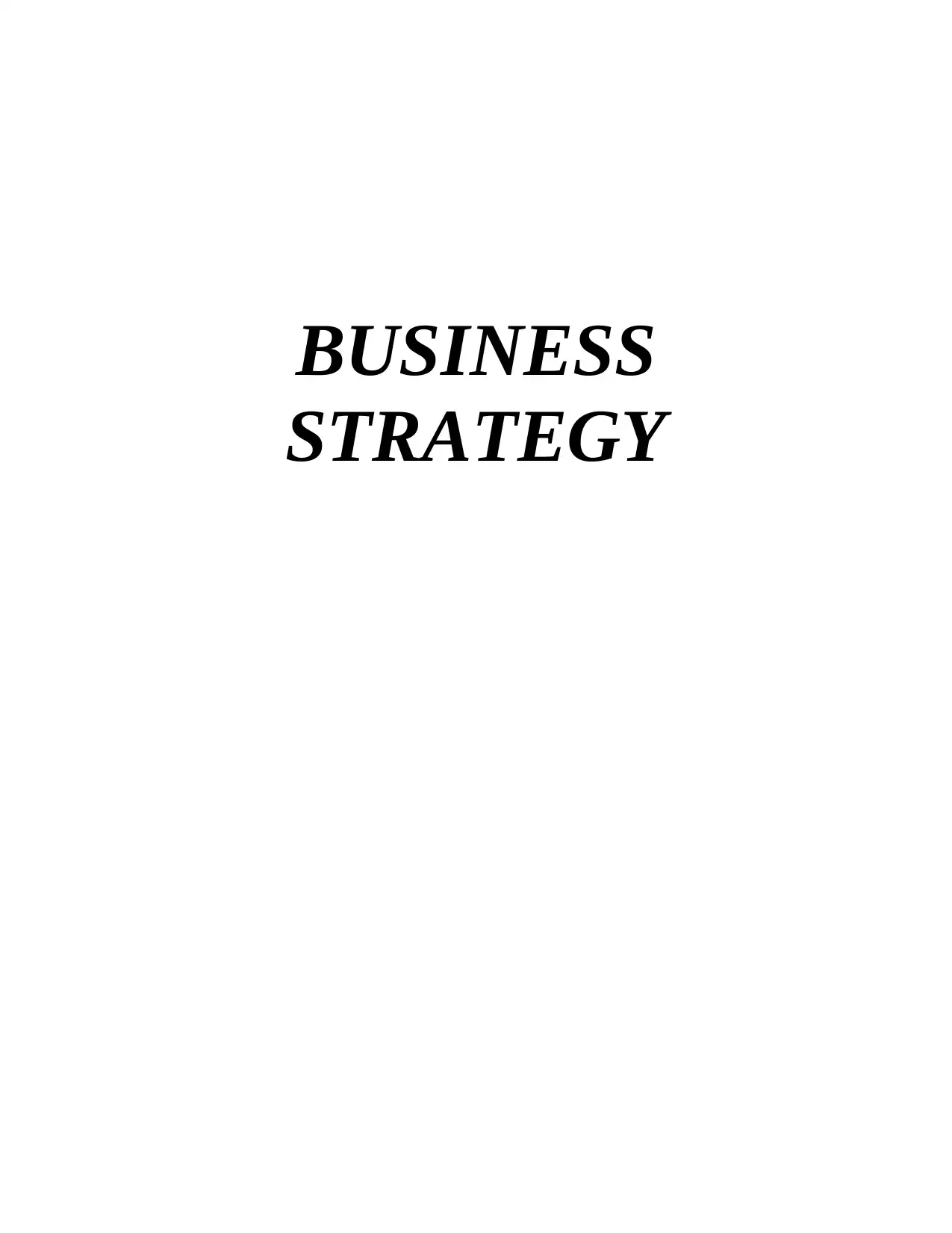
BUSINESS
STRATEGY
STRATEGY
Paraphrase This Document
Need a fresh take? Get an instant paraphrase of this document with our AI Paraphraser
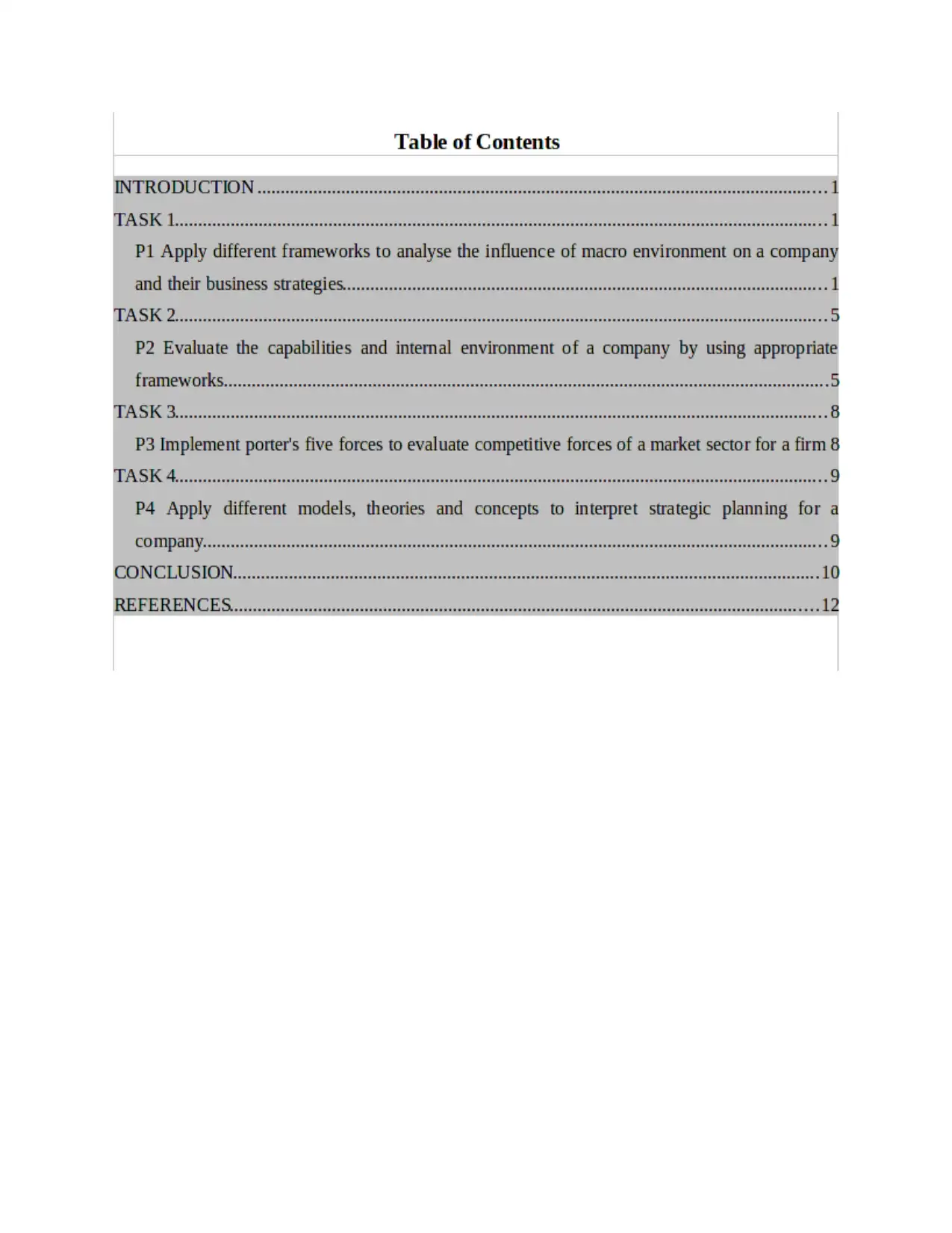
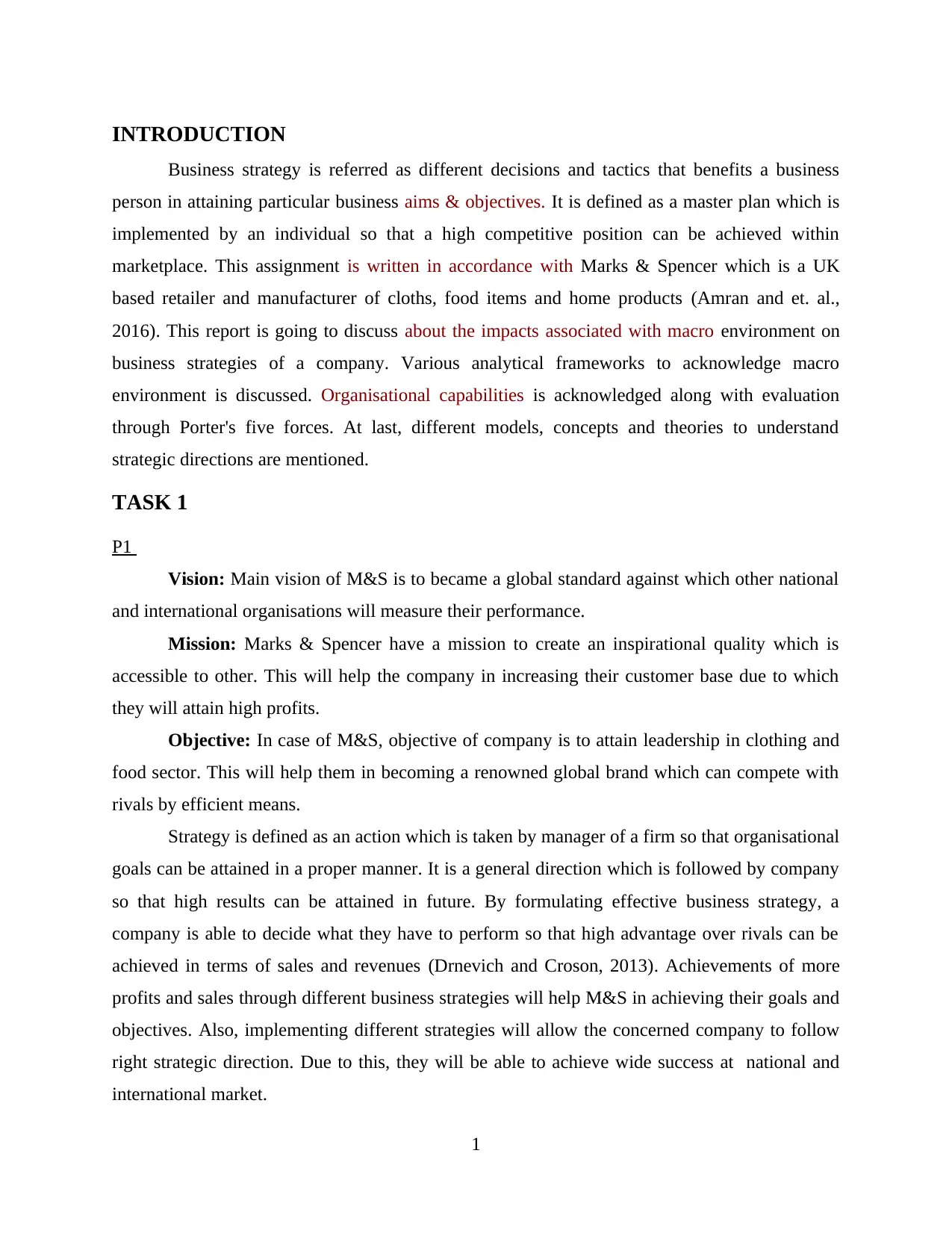
INTRODUCTION
Business strategy is referred as different decisions and tactics that benefits a business
person in attaining particular business aims & objectives. It is defined as a master plan which is
implemented by an individual so that a high competitive position can be achieved within
marketplace. This assignment is written in accordance with Marks & Spencer which is a UK
based retailer and manufacturer of cloths, food items and home products (Amran and et. al.,
2016). This report is going to discuss about the impacts associated with macro environment on
business strategies of a company. Various analytical frameworks to acknowledge macro
environment is discussed. Organisational capabilities is acknowledged along with evaluation
through Porter's five forces. At last, different models, concepts and theories to understand
strategic directions are mentioned.
TASK 1
P1
Vision: Main vision of M&S is to became a global standard against which other national
and international organisations will measure their performance.
Mission: Marks & Spencer have a mission to create an inspirational quality which is
accessible to other. This will help the company in increasing their customer base due to which
they will attain high profits.
Objective: In case of M&S, objective of company is to attain leadership in clothing and
food sector. This will help them in becoming a renowned global brand which can compete with
rivals by efficient means.
Strategy is defined as an action which is taken by manager of a firm so that organisational
goals can be attained in a proper manner. It is a general direction which is followed by company
so that high results can be attained in future. By formulating effective business strategy, a
company is able to decide what they have to perform so that high advantage over rivals can be
achieved in terms of sales and revenues (Drnevich and Croson, 2013). Achievements of more
profits and sales through different business strategies will help M&S in achieving their goals and
objectives. Also, implementing different strategies will allow the concerned company to follow
right strategic direction. Due to this, they will be able to achieve wide success at national and
international market.
1
Business strategy is referred as different decisions and tactics that benefits a business
person in attaining particular business aims & objectives. It is defined as a master plan which is
implemented by an individual so that a high competitive position can be achieved within
marketplace. This assignment is written in accordance with Marks & Spencer which is a UK
based retailer and manufacturer of cloths, food items and home products (Amran and et. al.,
2016). This report is going to discuss about the impacts associated with macro environment on
business strategies of a company. Various analytical frameworks to acknowledge macro
environment is discussed. Organisational capabilities is acknowledged along with evaluation
through Porter's five forces. At last, different models, concepts and theories to understand
strategic directions are mentioned.
TASK 1
P1
Vision: Main vision of M&S is to became a global standard against which other national
and international organisations will measure their performance.
Mission: Marks & Spencer have a mission to create an inspirational quality which is
accessible to other. This will help the company in increasing their customer base due to which
they will attain high profits.
Objective: In case of M&S, objective of company is to attain leadership in clothing and
food sector. This will help them in becoming a renowned global brand which can compete with
rivals by efficient means.
Strategy is defined as an action which is taken by manager of a firm so that organisational
goals can be attained in a proper manner. It is a general direction which is followed by company
so that high results can be attained in future. By formulating effective business strategy, a
company is able to decide what they have to perform so that high advantage over rivals can be
achieved in terms of sales and revenues (Drnevich and Croson, 2013). Achievements of more
profits and sales through different business strategies will help M&S in achieving their goals and
objectives. Also, implementing different strategies will allow the concerned company to follow
right strategic direction. Due to this, they will be able to achieve wide success at national and
international market.
1
⊘ This is a preview!⊘
Do you want full access?
Subscribe today to unlock all pages.

Trusted by 1+ million students worldwide
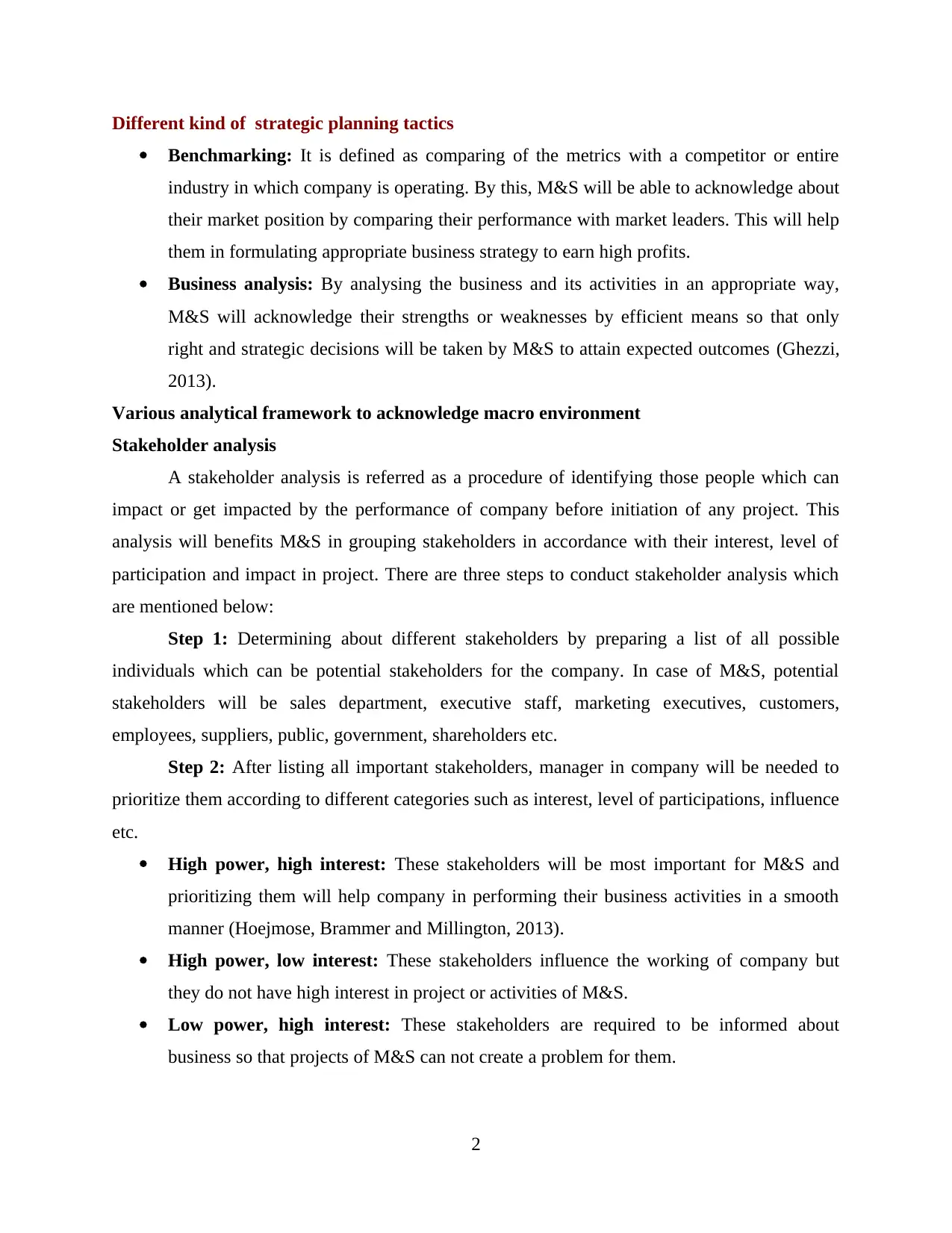
Different kind of strategic planning tactics
Benchmarking: It is defined as comparing of the metrics with a competitor or entire
industry in which company is operating. By this, M&S will be able to acknowledge about
their market position by comparing their performance with market leaders. This will help
them in formulating appropriate business strategy to earn high profits.
Business analysis: By analysing the business and its activities in an appropriate way,
M&S will acknowledge their strengths or weaknesses by efficient means so that only
right and strategic decisions will be taken by M&S to attain expected outcomes (Ghezzi,
2013).
Various analytical framework to acknowledge macro environment
Stakeholder analysis
A stakeholder analysis is referred as a procedure of identifying those people which can
impact or get impacted by the performance of company before initiation of any project. This
analysis will benefits M&S in grouping stakeholders in accordance with their interest, level of
participation and impact in project. There are three steps to conduct stakeholder analysis which
are mentioned below:
Step 1: Determining about different stakeholders by preparing a list of all possible
individuals which can be potential stakeholders for the company. In case of M&S, potential
stakeholders will be sales department, executive staff, marketing executives, customers,
employees, suppliers, public, government, shareholders etc.
Step 2: After listing all important stakeholders, manager in company will be needed to
prioritize them according to different categories such as interest, level of participations, influence
etc.
High power, high interest: These stakeholders will be most important for M&S and
prioritizing them will help company in performing their business activities in a smooth
manner (Hoejmose, Brammer and Millington, 2013).
High power, low interest: These stakeholders influence the working of company but
they do not have high interest in project or activities of M&S.
Low power, high interest: These stakeholders are required to be informed about
business so that projects of M&S can not create a problem for them.
2
Benchmarking: It is defined as comparing of the metrics with a competitor or entire
industry in which company is operating. By this, M&S will be able to acknowledge about
their market position by comparing their performance with market leaders. This will help
them in formulating appropriate business strategy to earn high profits.
Business analysis: By analysing the business and its activities in an appropriate way,
M&S will acknowledge their strengths or weaknesses by efficient means so that only
right and strategic decisions will be taken by M&S to attain expected outcomes (Ghezzi,
2013).
Various analytical framework to acknowledge macro environment
Stakeholder analysis
A stakeholder analysis is referred as a procedure of identifying those people which can
impact or get impacted by the performance of company before initiation of any project. This
analysis will benefits M&S in grouping stakeholders in accordance with their interest, level of
participation and impact in project. There are three steps to conduct stakeholder analysis which
are mentioned below:
Step 1: Determining about different stakeholders by preparing a list of all possible
individuals which can be potential stakeholders for the company. In case of M&S, potential
stakeholders will be sales department, executive staff, marketing executives, customers,
employees, suppliers, public, government, shareholders etc.
Step 2: After listing all important stakeholders, manager in company will be needed to
prioritize them according to different categories such as interest, level of participations, influence
etc.
High power, high interest: These stakeholders will be most important for M&S and
prioritizing them will help company in performing their business activities in a smooth
manner (Hoejmose, Brammer and Millington, 2013).
High power, low interest: These stakeholders influence the working of company but
they do not have high interest in project or activities of M&S.
Low power, high interest: These stakeholders are required to be informed about
business so that projects of M&S can not create a problem for them.
2
Paraphrase This Document
Need a fresh take? Get an instant paraphrase of this document with our AI Paraphraser
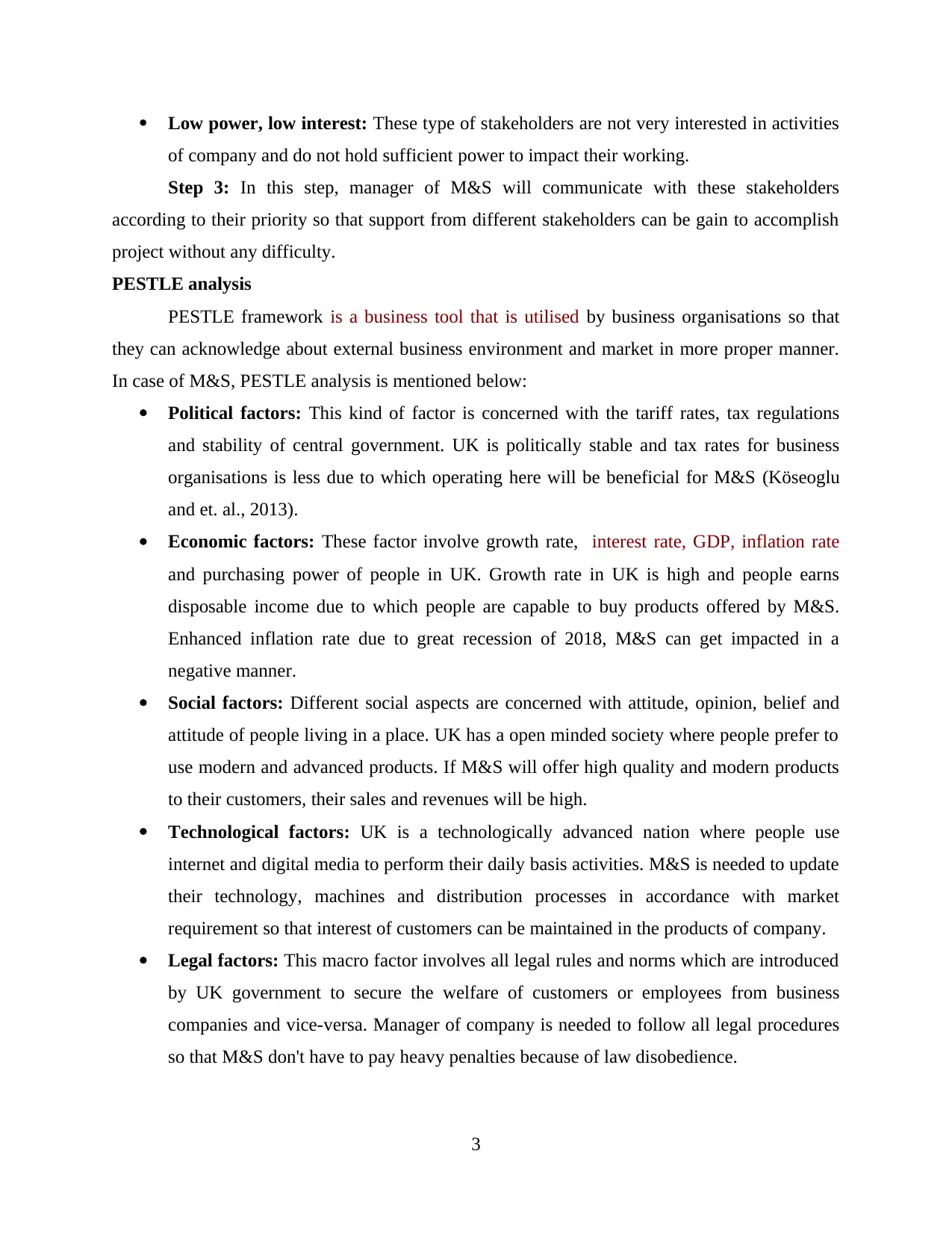
Low power, low interest: These type of stakeholders are not very interested in activities
of company and do not hold sufficient power to impact their working.
Step 3: In this step, manager of M&S will communicate with these stakeholders
according to their priority so that support from different stakeholders can be gain to accomplish
project without any difficulty.
PESTLE analysis
PESTLE framework is a business tool that is utilised by business organisations so that
they can acknowledge about external business environment and market in more proper manner.
In case of M&S, PESTLE analysis is mentioned below:
Political factors: This kind of factor is concerned with the tariff rates, tax regulations
and stability of central government. UK is politically stable and tax rates for business
organisations is less due to which operating here will be beneficial for M&S (Köseoglu
and et. al., 2013).
Economic factors: These factor involve growth rate, interest rate, GDP, inflation rate
and purchasing power of people in UK. Growth rate in UK is high and people earns
disposable income due to which people are capable to buy products offered by M&S.
Enhanced inflation rate due to great recession of 2018, M&S can get impacted in a
negative manner.
Social factors: Different social aspects are concerned with attitude, opinion, belief and
attitude of people living in a place. UK has a open minded society where people prefer to
use modern and advanced products. If M&S will offer high quality and modern products
to their customers, their sales and revenues will be high.
Technological factors: UK is a technologically advanced nation where people use
internet and digital media to perform their daily basis activities. M&S is needed to update
their technology, machines and distribution processes in accordance with market
requirement so that interest of customers can be maintained in the products of company.
Legal factors: This macro factor involves all legal rules and norms which are introduced
by UK government to secure the welfare of customers or employees from business
companies and vice-versa. Manager of company is needed to follow all legal procedures
so that M&S don't have to pay heavy penalties because of law disobedience.
3
of company and do not hold sufficient power to impact their working.
Step 3: In this step, manager of M&S will communicate with these stakeholders
according to their priority so that support from different stakeholders can be gain to accomplish
project without any difficulty.
PESTLE analysis
PESTLE framework is a business tool that is utilised by business organisations so that
they can acknowledge about external business environment and market in more proper manner.
In case of M&S, PESTLE analysis is mentioned below:
Political factors: This kind of factor is concerned with the tariff rates, tax regulations
and stability of central government. UK is politically stable and tax rates for business
organisations is less due to which operating here will be beneficial for M&S (Köseoglu
and et. al., 2013).
Economic factors: These factor involve growth rate, interest rate, GDP, inflation rate
and purchasing power of people in UK. Growth rate in UK is high and people earns
disposable income due to which people are capable to buy products offered by M&S.
Enhanced inflation rate due to great recession of 2018, M&S can get impacted in a
negative manner.
Social factors: Different social aspects are concerned with attitude, opinion, belief and
attitude of people living in a place. UK has a open minded society where people prefer to
use modern and advanced products. If M&S will offer high quality and modern products
to their customers, their sales and revenues will be high.
Technological factors: UK is a technologically advanced nation where people use
internet and digital media to perform their daily basis activities. M&S is needed to update
their technology, machines and distribution processes in accordance with market
requirement so that interest of customers can be maintained in the products of company.
Legal factors: This macro factor involves all legal rules and norms which are introduced
by UK government to secure the welfare of customers or employees from business
companies and vice-versa. Manager of company is needed to follow all legal procedures
so that M&S don't have to pay heavy penalties because of law disobedience.
3
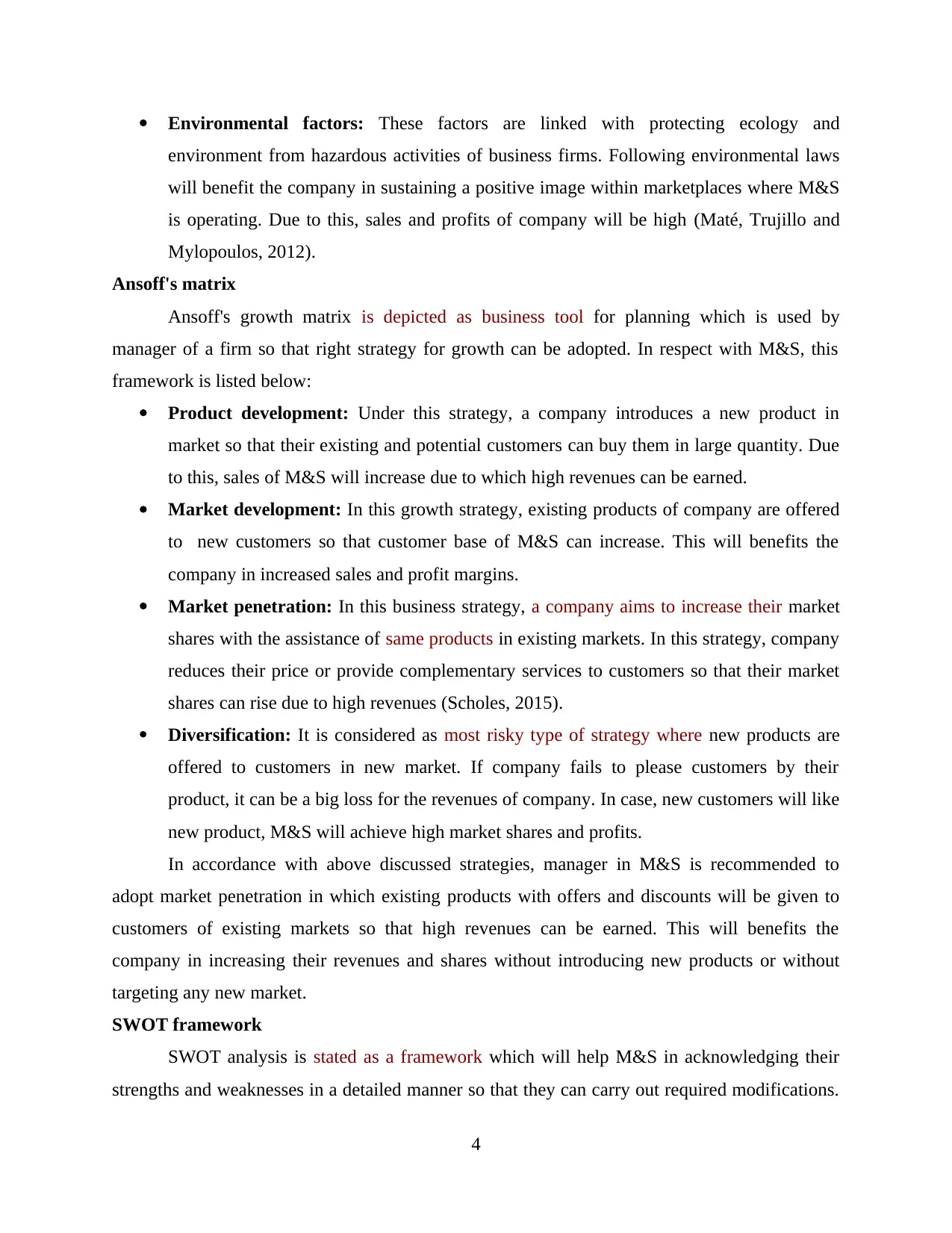
Environmental factors: These factors are linked with protecting ecology and
environment from hazardous activities of business firms. Following environmental laws
will benefit the company in sustaining a positive image within marketplaces where M&S
is operating. Due to this, sales and profits of company will be high (Maté, Trujillo and
Mylopoulos, 2012).
Ansoff's matrix
Ansoff's growth matrix is depicted as business tool for planning which is used by
manager of a firm so that right strategy for growth can be adopted. In respect with M&S, this
framework is listed below:
Product development: Under this strategy, a company introduces a new product in
market so that their existing and potential customers can buy them in large quantity. Due
to this, sales of M&S will increase due to which high revenues can be earned.
Market development: In this growth strategy, existing products of company are offered
to new customers so that customer base of M&S can increase. This will benefits the
company in increased sales and profit margins.
Market penetration: In this business strategy, a company aims to increase their market
shares with the assistance of same products in existing markets. In this strategy, company
reduces their price or provide complementary services to customers so that their market
shares can rise due to high revenues (Scholes, 2015).
Diversification: It is considered as most risky type of strategy where new products are
offered to customers in new market. If company fails to please customers by their
product, it can be a big loss for the revenues of company. In case, new customers will like
new product, M&S will achieve high market shares and profits.
In accordance with above discussed strategies, manager in M&S is recommended to
adopt market penetration in which existing products with offers and discounts will be given to
customers of existing markets so that high revenues can be earned. This will benefits the
company in increasing their revenues and shares without introducing new products or without
targeting any new market.
SWOT framework
SWOT analysis is stated as a framework which will help M&S in acknowledging their
strengths and weaknesses in a detailed manner so that they can carry out required modifications.
4
environment from hazardous activities of business firms. Following environmental laws
will benefit the company in sustaining a positive image within marketplaces where M&S
is operating. Due to this, sales and profits of company will be high (Maté, Trujillo and
Mylopoulos, 2012).
Ansoff's matrix
Ansoff's growth matrix is depicted as business tool for planning which is used by
manager of a firm so that right strategy for growth can be adopted. In respect with M&S, this
framework is listed below:
Product development: Under this strategy, a company introduces a new product in
market so that their existing and potential customers can buy them in large quantity. Due
to this, sales of M&S will increase due to which high revenues can be earned.
Market development: In this growth strategy, existing products of company are offered
to new customers so that customer base of M&S can increase. This will benefits the
company in increased sales and profit margins.
Market penetration: In this business strategy, a company aims to increase their market
shares with the assistance of same products in existing markets. In this strategy, company
reduces their price or provide complementary services to customers so that their market
shares can rise due to high revenues (Scholes, 2015).
Diversification: It is considered as most risky type of strategy where new products are
offered to customers in new market. If company fails to please customers by their
product, it can be a big loss for the revenues of company. In case, new customers will like
new product, M&S will achieve high market shares and profits.
In accordance with above discussed strategies, manager in M&S is recommended to
adopt market penetration in which existing products with offers and discounts will be given to
customers of existing markets so that high revenues can be earned. This will benefits the
company in increasing their revenues and shares without introducing new products or without
targeting any new market.
SWOT framework
SWOT analysis is stated as a framework which will help M&S in acknowledging their
strengths and weaknesses in a detailed manner so that they can carry out required modifications.
4
⊘ This is a preview!⊘
Do you want full access?
Subscribe today to unlock all pages.

Trusted by 1+ million students worldwide
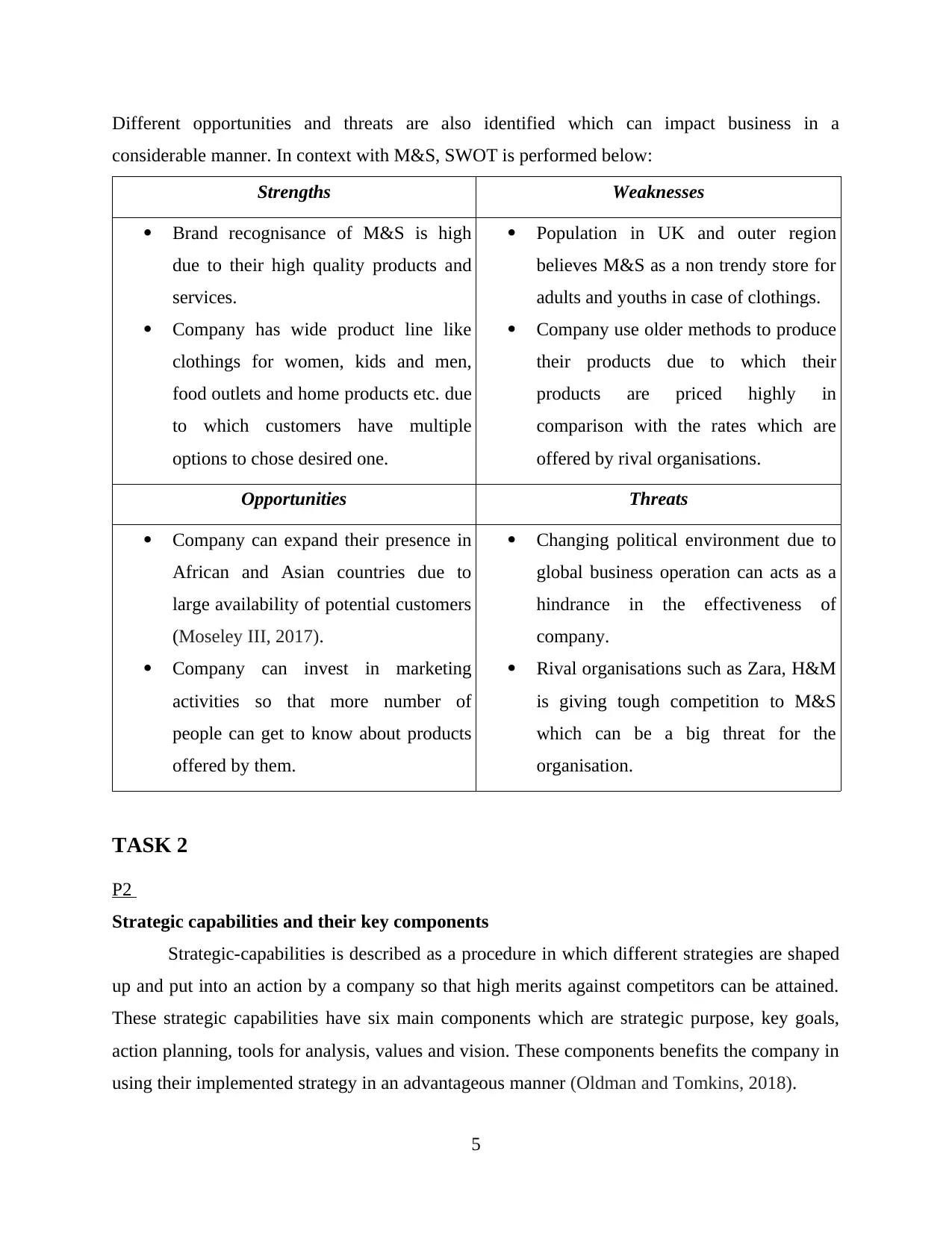
Different opportunities and threats are also identified which can impact business in a
considerable manner. In context with M&S, SWOT is performed below:
Strengths Weaknesses
Brand recognisance of M&S is high
due to their high quality products and
services.
Company has wide product line like
clothings for women, kids and men,
food outlets and home products etc. due
to which customers have multiple
options to chose desired one.
Population in UK and outer region
believes M&S as a non trendy store for
adults and youths in case of clothings.
Company use older methods to produce
their products due to which their
products are priced highly in
comparison with the rates which are
offered by rival organisations.
Opportunities Threats
Company can expand their presence in
African and Asian countries due to
large availability of potential customers
(Moseley III, 2017).
Company can invest in marketing
activities so that more number of
people can get to know about products
offered by them.
Changing political environment due to
global business operation can acts as a
hindrance in the effectiveness of
company.
Rival organisations such as Zara, H&M
is giving tough competition to M&S
which can be a big threat for the
organisation.
TASK 2
P2
Strategic capabilities and their key components
Strategic-capabilities is described as a procedure in which different strategies are shaped
up and put into an action by a company so that high merits against competitors can be attained.
These strategic capabilities have six main components which are strategic purpose, key goals,
action planning, tools for analysis, values and vision. These components benefits the company in
using their implemented strategy in an advantageous manner (Oldman and Tomkins, 2018).
5
considerable manner. In context with M&S, SWOT is performed below:
Strengths Weaknesses
Brand recognisance of M&S is high
due to their high quality products and
services.
Company has wide product line like
clothings for women, kids and men,
food outlets and home products etc. due
to which customers have multiple
options to chose desired one.
Population in UK and outer region
believes M&S as a non trendy store for
adults and youths in case of clothings.
Company use older methods to produce
their products due to which their
products are priced highly in
comparison with the rates which are
offered by rival organisations.
Opportunities Threats
Company can expand their presence in
African and Asian countries due to
large availability of potential customers
(Moseley III, 2017).
Company can invest in marketing
activities so that more number of
people can get to know about products
offered by them.
Changing political environment due to
global business operation can acts as a
hindrance in the effectiveness of
company.
Rival organisations such as Zara, H&M
is giving tough competition to M&S
which can be a big threat for the
organisation.
TASK 2
P2
Strategic capabilities and their key components
Strategic-capabilities is described as a procedure in which different strategies are shaped
up and put into an action by a company so that high merits against competitors can be attained.
These strategic capabilities have six main components which are strategic purpose, key goals,
action planning, tools for analysis, values and vision. These components benefits the company in
using their implemented strategy in an advantageous manner (Oldman and Tomkins, 2018).
5
Paraphrase This Document
Need a fresh take? Get an instant paraphrase of this document with our AI Paraphraser
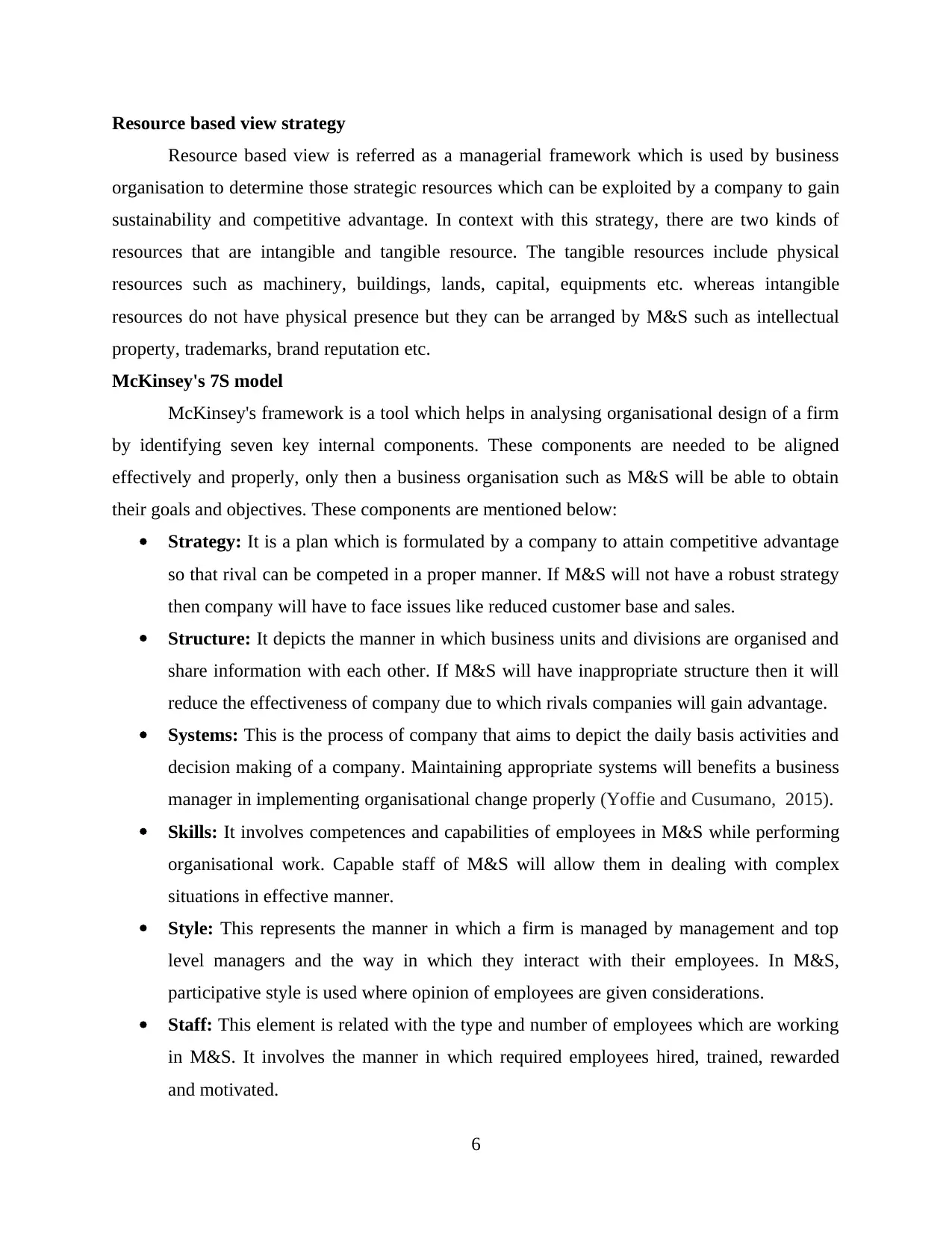
Resource based view strategy
Resource based view is referred as a managerial framework which is used by business
organisation to determine those strategic resources which can be exploited by a company to gain
sustainability and competitive advantage. In context with this strategy, there are two kinds of
resources that are intangible and tangible resource. The tangible resources include physical
resources such as machinery, buildings, lands, capital, equipments etc. whereas intangible
resources do not have physical presence but they can be arranged by M&S such as intellectual
property, trademarks, brand reputation etc.
McKinsey's 7S model
McKinsey's framework is a tool which helps in analysing organisational design of a firm
by identifying seven key internal components. These components are needed to be aligned
effectively and properly, only then a business organisation such as M&S will be able to obtain
their goals and objectives. These components are mentioned below:
Strategy: It is a plan which is formulated by a company to attain competitive advantage
so that rival can be competed in a proper manner. If M&S will not have a robust strategy
then company will have to face issues like reduced customer base and sales.
Structure: It depicts the manner in which business units and divisions are organised and
share information with each other. If M&S will have inappropriate structure then it will
reduce the effectiveness of company due to which rivals companies will gain advantage.
Systems: This is the process of company that aims to depict the daily basis activities and
decision making of a company. Maintaining appropriate systems will benefits a business
manager in implementing organisational change properly (Yoffie and Cusumano, 2015).
Skills: It involves competences and capabilities of employees in M&S while performing
organisational work. Capable staff of M&S will allow them in dealing with complex
situations in effective manner.
Style: This represents the manner in which a firm is managed by management and top
level managers and the way in which they interact with their employees. In M&S,
participative style is used where opinion of employees are given considerations.
Staff: This element is related with the type and number of employees which are working
in M&S. It involves the manner in which required employees hired, trained, rewarded
and motivated.
6
Resource based view is referred as a managerial framework which is used by business
organisation to determine those strategic resources which can be exploited by a company to gain
sustainability and competitive advantage. In context with this strategy, there are two kinds of
resources that are intangible and tangible resource. The tangible resources include physical
resources such as machinery, buildings, lands, capital, equipments etc. whereas intangible
resources do not have physical presence but they can be arranged by M&S such as intellectual
property, trademarks, brand reputation etc.
McKinsey's 7S model
McKinsey's framework is a tool which helps in analysing organisational design of a firm
by identifying seven key internal components. These components are needed to be aligned
effectively and properly, only then a business organisation such as M&S will be able to obtain
their goals and objectives. These components are mentioned below:
Strategy: It is a plan which is formulated by a company to attain competitive advantage
so that rival can be competed in a proper manner. If M&S will not have a robust strategy
then company will have to face issues like reduced customer base and sales.
Structure: It depicts the manner in which business units and divisions are organised and
share information with each other. If M&S will have inappropriate structure then it will
reduce the effectiveness of company due to which rivals companies will gain advantage.
Systems: This is the process of company that aims to depict the daily basis activities and
decision making of a company. Maintaining appropriate systems will benefits a business
manager in implementing organisational change properly (Yoffie and Cusumano, 2015).
Skills: It involves competences and capabilities of employees in M&S while performing
organisational work. Capable staff of M&S will allow them in dealing with complex
situations in effective manner.
Style: This represents the manner in which a firm is managed by management and top
level managers and the way in which they interact with their employees. In M&S,
participative style is used where opinion of employees are given considerations.
Staff: This element is related with the type and number of employees which are working
in M&S. It involves the manner in which required employees hired, trained, rewarded
and motivated.
6
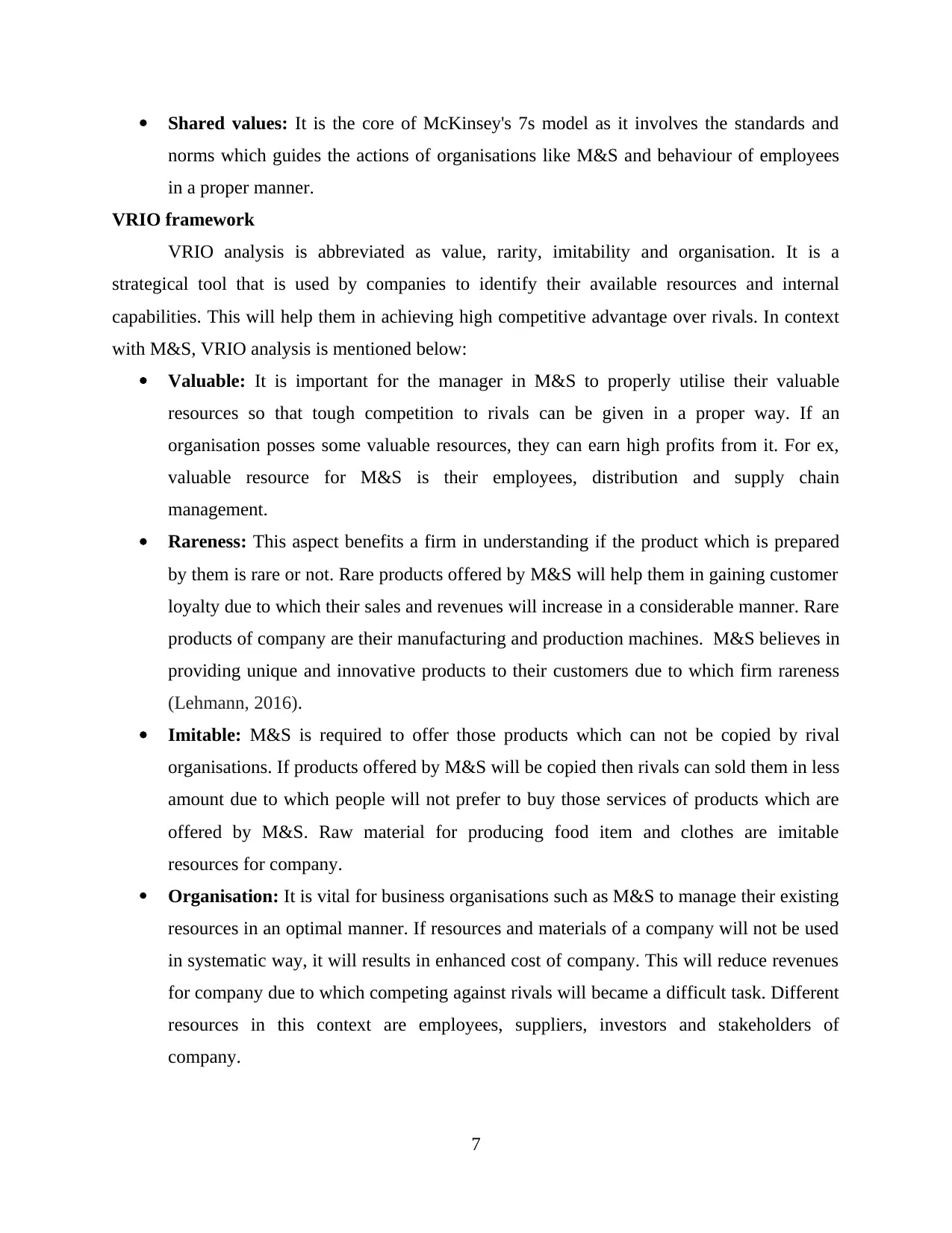
Shared values: It is the core of McKinsey's 7s model as it involves the standards and
norms which guides the actions of organisations like M&S and behaviour of employees
in a proper manner.
VRIO framework
VRIO analysis is abbreviated as value, rarity, imitability and organisation. It is a
strategical tool that is used by companies to identify their available resources and internal
capabilities. This will help them in achieving high competitive advantage over rivals. In context
with M&S, VRIO analysis is mentioned below:
Valuable: It is important for the manager in M&S to properly utilise their valuable
resources so that tough competition to rivals can be given in a proper way. If an
organisation posses some valuable resources, they can earn high profits from it. For ex,
valuable resource for M&S is their employees, distribution and supply chain
management.
Rareness: This aspect benefits a firm in understanding if the product which is prepared
by them is rare or not. Rare products offered by M&S will help them in gaining customer
loyalty due to which their sales and revenues will increase in a considerable manner. Rare
products of company are their manufacturing and production machines. M&S believes in
providing unique and innovative products to their customers due to which firm rareness
(Lehmann, 2016).
Imitable: M&S is required to offer those products which can not be copied by rival
organisations. If products offered by M&S will be copied then rivals can sold them in less
amount due to which people will not prefer to buy those services of products which are
offered by M&S. Raw material for producing food item and clothes are imitable
resources for company.
Organisation: It is vital for business organisations such as M&S to manage their existing
resources in an optimal manner. If resources and materials of a company will not be used
in systematic way, it will results in enhanced cost of company. This will reduce revenues
for company due to which competing against rivals will became a difficult task. Different
resources in this context are employees, suppliers, investors and stakeholders of
company.
7
norms which guides the actions of organisations like M&S and behaviour of employees
in a proper manner.
VRIO framework
VRIO analysis is abbreviated as value, rarity, imitability and organisation. It is a
strategical tool that is used by companies to identify their available resources and internal
capabilities. This will help them in achieving high competitive advantage over rivals. In context
with M&S, VRIO analysis is mentioned below:
Valuable: It is important for the manager in M&S to properly utilise their valuable
resources so that tough competition to rivals can be given in a proper way. If an
organisation posses some valuable resources, they can earn high profits from it. For ex,
valuable resource for M&S is their employees, distribution and supply chain
management.
Rareness: This aspect benefits a firm in understanding if the product which is prepared
by them is rare or not. Rare products offered by M&S will help them in gaining customer
loyalty due to which their sales and revenues will increase in a considerable manner. Rare
products of company are their manufacturing and production machines. M&S believes in
providing unique and innovative products to their customers due to which firm rareness
(Lehmann, 2016).
Imitable: M&S is required to offer those products which can not be copied by rival
organisations. If products offered by M&S will be copied then rivals can sold them in less
amount due to which people will not prefer to buy those services of products which are
offered by M&S. Raw material for producing food item and clothes are imitable
resources for company.
Organisation: It is vital for business organisations such as M&S to manage their existing
resources in an optimal manner. If resources and materials of a company will not be used
in systematic way, it will results in enhanced cost of company. This will reduce revenues
for company due to which competing against rivals will became a difficult task. Different
resources in this context are employees, suppliers, investors and stakeholders of
company.
7
⊘ This is a preview!⊘
Do you want full access?
Subscribe today to unlock all pages.

Trusted by 1+ million students worldwide
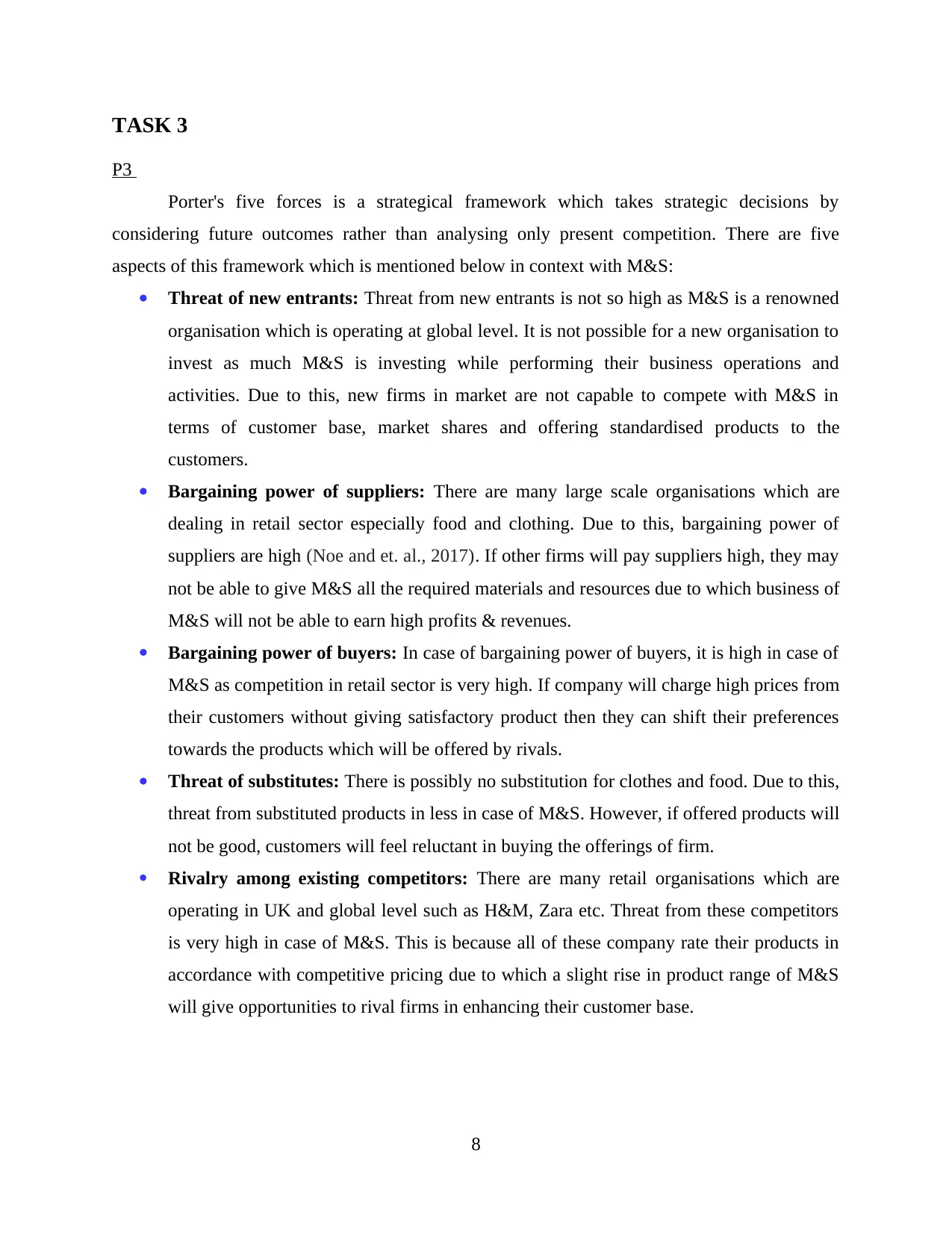
TASK 3
P3
Porter's five forces is a strategical framework which takes strategic decisions by
considering future outcomes rather than analysing only present competition. There are five
aspects of this framework which is mentioned below in context with M&S:
Threat of new entrants: Threat from new entrants is not so high as M&S is a renowned
organisation which is operating at global level. It is not possible for a new organisation to
invest as much M&S is investing while performing their business operations and
activities. Due to this, new firms in market are not capable to compete with M&S in
terms of customer base, market shares and offering standardised products to the
customers.
Bargaining power of suppliers: There are many large scale organisations which are
dealing in retail sector especially food and clothing. Due to this, bargaining power of
suppliers are high (Noe and et. al., 2017). If other firms will pay suppliers high, they may
not be able to give M&S all the required materials and resources due to which business of
M&S will not be able to earn high profits & revenues.
Bargaining power of buyers: In case of bargaining power of buyers, it is high in case of
M&S as competition in retail sector is very high. If company will charge high prices from
their customers without giving satisfactory product then they can shift their preferences
towards the products which will be offered by rivals.
Threat of substitutes: There is possibly no substitution for clothes and food. Due to this,
threat from substituted products in less in case of M&S. However, if offered products will
not be good, customers will feel reluctant in buying the offerings of firm.
Rivalry among existing competitors: There are many retail organisations which are
operating in UK and global level such as H&M, Zara etc. Threat from these competitors
is very high in case of M&S. This is because all of these company rate their products in
accordance with competitive pricing due to which a slight rise in product range of M&S
will give opportunities to rival firms in enhancing their customer base.
8
P3
Porter's five forces is a strategical framework which takes strategic decisions by
considering future outcomes rather than analysing only present competition. There are five
aspects of this framework which is mentioned below in context with M&S:
Threat of new entrants: Threat from new entrants is not so high as M&S is a renowned
organisation which is operating at global level. It is not possible for a new organisation to
invest as much M&S is investing while performing their business operations and
activities. Due to this, new firms in market are not capable to compete with M&S in
terms of customer base, market shares and offering standardised products to the
customers.
Bargaining power of suppliers: There are many large scale organisations which are
dealing in retail sector especially food and clothing. Due to this, bargaining power of
suppliers are high (Noe and et. al., 2017). If other firms will pay suppliers high, they may
not be able to give M&S all the required materials and resources due to which business of
M&S will not be able to earn high profits & revenues.
Bargaining power of buyers: In case of bargaining power of buyers, it is high in case of
M&S as competition in retail sector is very high. If company will charge high prices from
their customers without giving satisfactory product then they can shift their preferences
towards the products which will be offered by rivals.
Threat of substitutes: There is possibly no substitution for clothes and food. Due to this,
threat from substituted products in less in case of M&S. However, if offered products will
not be good, customers will feel reluctant in buying the offerings of firm.
Rivalry among existing competitors: There are many retail organisations which are
operating in UK and global level such as H&M, Zara etc. Threat from these competitors
is very high in case of M&S. This is because all of these company rate their products in
accordance with competitive pricing due to which a slight rise in product range of M&S
will give opportunities to rival firms in enhancing their customer base.
8
Paraphrase This Document
Need a fresh take? Get an instant paraphrase of this document with our AI Paraphraser
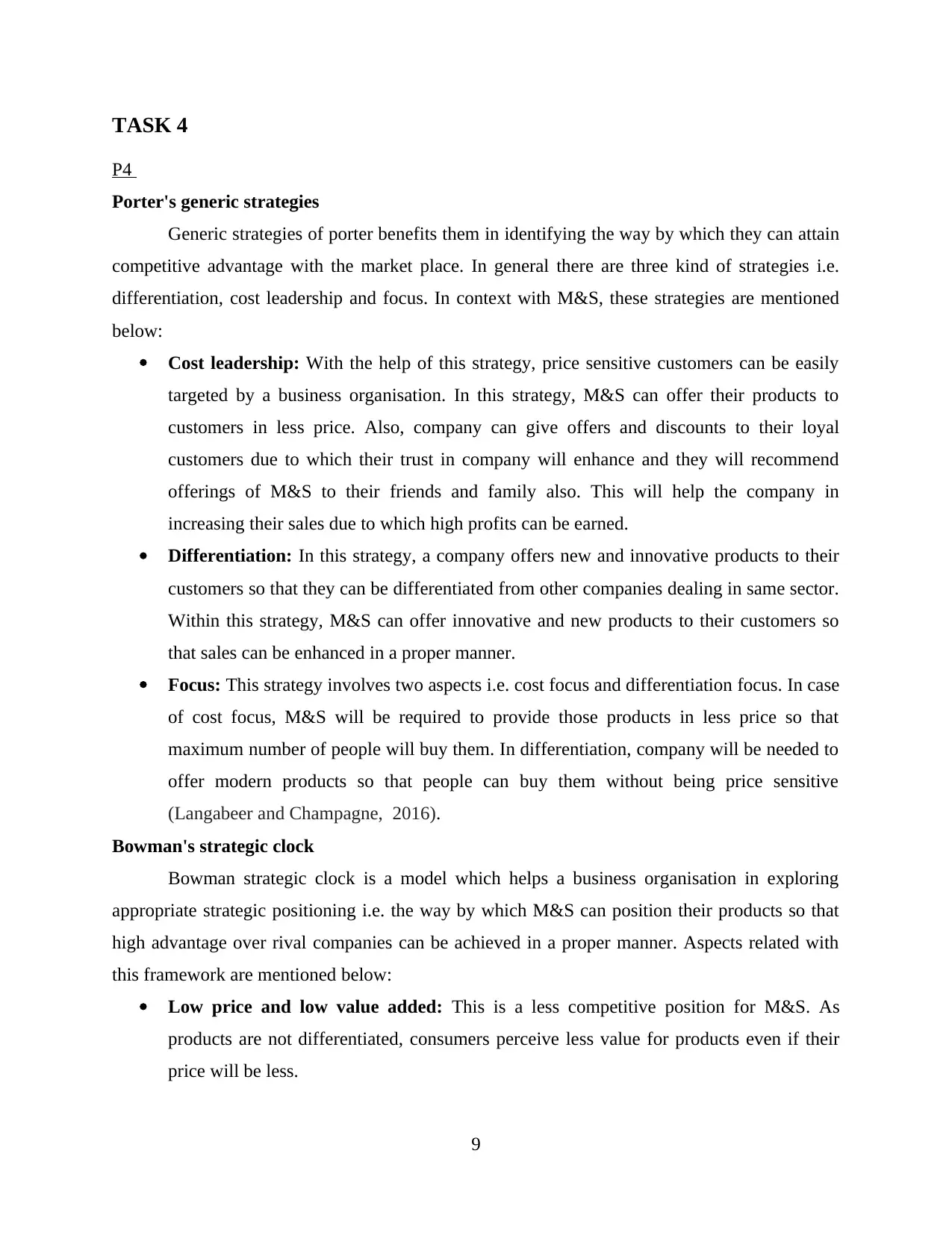
TASK 4
P4
Porter's generic strategies
Generic strategies of porter benefits them in identifying the way by which they can attain
competitive advantage with the market place. In general there are three kind of strategies i.e.
differentiation, cost leadership and focus. In context with M&S, these strategies are mentioned
below:
Cost leadership: With the help of this strategy, price sensitive customers can be easily
targeted by a business organisation. In this strategy, M&S can offer their products to
customers in less price. Also, company can give offers and discounts to their loyal
customers due to which their trust in company will enhance and they will recommend
offerings of M&S to their friends and family also. This will help the company in
increasing their sales due to which high profits can be earned.
Differentiation: In this strategy, a company offers new and innovative products to their
customers so that they can be differentiated from other companies dealing in same sector.
Within this strategy, M&S can offer innovative and new products to their customers so
that sales can be enhanced in a proper manner.
Focus: This strategy involves two aspects i.e. cost focus and differentiation focus. In case
of cost focus, M&S will be required to provide those products in less price so that
maximum number of people will buy them. In differentiation, company will be needed to
offer modern products so that people can buy them without being price sensitive
(Langabeer and Champagne, 2016).
Bowman's strategic clock
Bowman strategic clock is a model which helps a business organisation in exploring
appropriate strategic positioning i.e. the way by which M&S can position their products so that
high advantage over rival companies can be achieved in a proper manner. Aspects related with
this framework are mentioned below:
Low price and low value added: This is a less competitive position for M&S. As
products are not differentiated, consumers perceive less value for products even if their
price will be less.
9
P4
Porter's generic strategies
Generic strategies of porter benefits them in identifying the way by which they can attain
competitive advantage with the market place. In general there are three kind of strategies i.e.
differentiation, cost leadership and focus. In context with M&S, these strategies are mentioned
below:
Cost leadership: With the help of this strategy, price sensitive customers can be easily
targeted by a business organisation. In this strategy, M&S can offer their products to
customers in less price. Also, company can give offers and discounts to their loyal
customers due to which their trust in company will enhance and they will recommend
offerings of M&S to their friends and family also. This will help the company in
increasing their sales due to which high profits can be earned.
Differentiation: In this strategy, a company offers new and innovative products to their
customers so that they can be differentiated from other companies dealing in same sector.
Within this strategy, M&S can offer innovative and new products to their customers so
that sales can be enhanced in a proper manner.
Focus: This strategy involves two aspects i.e. cost focus and differentiation focus. In case
of cost focus, M&S will be required to provide those products in less price so that
maximum number of people will buy them. In differentiation, company will be needed to
offer modern products so that people can buy them without being price sensitive
(Langabeer and Champagne, 2016).
Bowman's strategic clock
Bowman strategic clock is a model which helps a business organisation in exploring
appropriate strategic positioning i.e. the way by which M&S can position their products so that
high advantage over rival companies can be achieved in a proper manner. Aspects related with
this framework are mentioned below:
Low price and low value added: This is a less competitive position for M&S. As
products are not differentiated, consumers perceive less value for products even if their
price will be less.
9
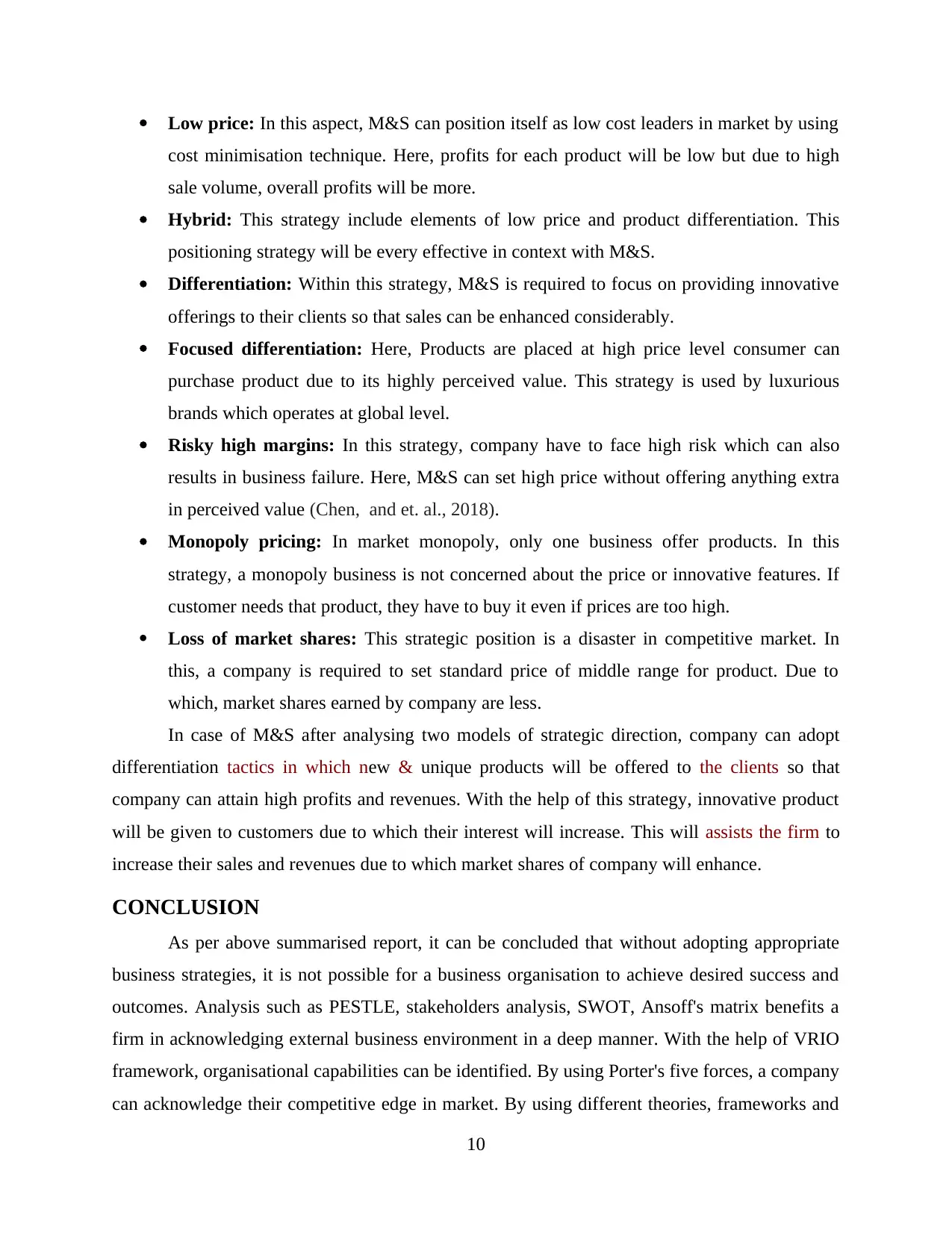
Low price: In this aspect, M&S can position itself as low cost leaders in market by using
cost minimisation technique. Here, profits for each product will be low but due to high
sale volume, overall profits will be more.
Hybrid: This strategy include elements of low price and product differentiation. This
positioning strategy will be every effective in context with M&S.
Differentiation: Within this strategy, M&S is required to focus on providing innovative
offerings to their clients so that sales can be enhanced considerably.
Focused differentiation: Here, Products are placed at high price level consumer can
purchase product due to its highly perceived value. This strategy is used by luxurious
brands which operates at global level.
Risky high margins: In this strategy, company have to face high risk which can also
results in business failure. Here, M&S can set high price without offering anything extra
in perceived value (Chen, and et. al., 2018).
Monopoly pricing: In market monopoly, only one business offer products. In this
strategy, a monopoly business is not concerned about the price or innovative features. If
customer needs that product, they have to buy it even if prices are too high.
Loss of market shares: This strategic position is a disaster in competitive market. In
this, a company is required to set standard price of middle range for product. Due to
which, market shares earned by company are less.
In case of M&S after analysing two models of strategic direction, company can adopt
differentiation tactics in which new & unique products will be offered to the clients so that
company can attain high profits and revenues. With the help of this strategy, innovative product
will be given to customers due to which their interest will increase. This will assists the firm to
increase their sales and revenues due to which market shares of company will enhance.
CONCLUSION
As per above summarised report, it can be concluded that without adopting appropriate
business strategies, it is not possible for a business organisation to achieve desired success and
outcomes. Analysis such as PESTLE, stakeholders analysis, SWOT, Ansoff's matrix benefits a
firm in acknowledging external business environment in a deep manner. With the help of VRIO
framework, organisational capabilities can be identified. By using Porter's five forces, a company
can acknowledge their competitive edge in market. By using different theories, frameworks and
10
cost minimisation technique. Here, profits for each product will be low but due to high
sale volume, overall profits will be more.
Hybrid: This strategy include elements of low price and product differentiation. This
positioning strategy will be every effective in context with M&S.
Differentiation: Within this strategy, M&S is required to focus on providing innovative
offerings to their clients so that sales can be enhanced considerably.
Focused differentiation: Here, Products are placed at high price level consumer can
purchase product due to its highly perceived value. This strategy is used by luxurious
brands which operates at global level.
Risky high margins: In this strategy, company have to face high risk which can also
results in business failure. Here, M&S can set high price without offering anything extra
in perceived value (Chen, and et. al., 2018).
Monopoly pricing: In market monopoly, only one business offer products. In this
strategy, a monopoly business is not concerned about the price or innovative features. If
customer needs that product, they have to buy it even if prices are too high.
Loss of market shares: This strategic position is a disaster in competitive market. In
this, a company is required to set standard price of middle range for product. Due to
which, market shares earned by company are less.
In case of M&S after analysing two models of strategic direction, company can adopt
differentiation tactics in which new & unique products will be offered to the clients so that
company can attain high profits and revenues. With the help of this strategy, innovative product
will be given to customers due to which their interest will increase. This will assists the firm to
increase their sales and revenues due to which market shares of company will enhance.
CONCLUSION
As per above summarised report, it can be concluded that without adopting appropriate
business strategies, it is not possible for a business organisation to achieve desired success and
outcomes. Analysis such as PESTLE, stakeholders analysis, SWOT, Ansoff's matrix benefits a
firm in acknowledging external business environment in a deep manner. With the help of VRIO
framework, organisational capabilities can be identified. By using Porter's five forces, a company
can acknowledge their competitive edge in market. By using different theories, frameworks and
10
⊘ This is a preview!⊘
Do you want full access?
Subscribe today to unlock all pages.

Trusted by 1+ million students worldwide
1 out of 14
Related Documents
Your All-in-One AI-Powered Toolkit for Academic Success.
+13062052269
info@desklib.com
Available 24*7 on WhatsApp / Email
![[object Object]](/_next/static/media/star-bottom.7253800d.svg)
Unlock your academic potential
Copyright © 2020–2025 A2Z Services. All Rights Reserved. Developed and managed by ZUCOL.



